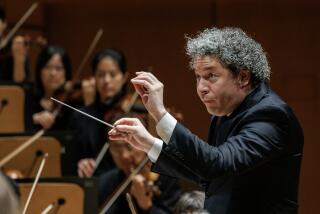MUSIC REVIEW : Pianist Tiempo Makes His Local Debut at Ambassador
- Share via
Precocious youth being a hot commodity in the music world at present, numbers count for something. It is not enough to recognize that the impressive Venezuelan pianist Sergio Daniel Tiempo, who made his local debut in recital at Ambassador Auditorium on Monday, is all of 22 years old.
We ought also to realize that he was born just as Richard Nixon was beginning his descent, and that Tiempo made his professional debut in Amsterdam at 14.
As it turned out, Tiempo strode onstage in Pasadena, in black pants and ocean-blue dress shirt, looking less than his years. And, when all was played and done, he sounded well beyond his years. Tiempo has a sure-fire, spitfire dexterity and a bravura that he can’t hide even beneath carefully muted dynamics or moody persuasions. He is also well on his way to developing an original voice.
In a healthy cross-historical program, Tiempo traversed the Baroque restraint of Scarlatti, the varied Romanticism of Chopin and Lizst and the foggier Impressionist turf of Ravel. While the later pianistic showpieces played up the pianist’s considerable digital skill, his crystalline approach to Scarlatti may have accounted for the evening’s finest music-making, now charging forward, now tracing an exquisite melancholy.
With Chopin, Tiempo seemed to have trouble finding a unified perspective, as lucid melodic motives danced disjointedly atop murky clouds of supportive material. However, his reading of Chopin’s “Grande Polonaise Brillante,” broadly witty and full of technical flourish, closed the first half boldly.
To Ravel’s “Gaspard de la nuit,” with its balance of nocturnal airs and virtuosic bursts, Tiempo brought a muscular brand of impressionistic interpretation. The dangerous curves and flamboyant landscape of Lizst’s “Mephisto” Waltz proved an ideal foil for Tiempo’s dazzling technique, fodder for standing ovations. He gave a generous three encores, closing with a lovable quirk, “Boite Musique,” by his former teacher, Pierre Sancan.
More to Read
The biggest entertainment stories
Get our big stories about Hollywood, film, television, music, arts, culture and more right in your inbox as soon as they publish.
You may occasionally receive promotional content from the Los Angeles Times.










